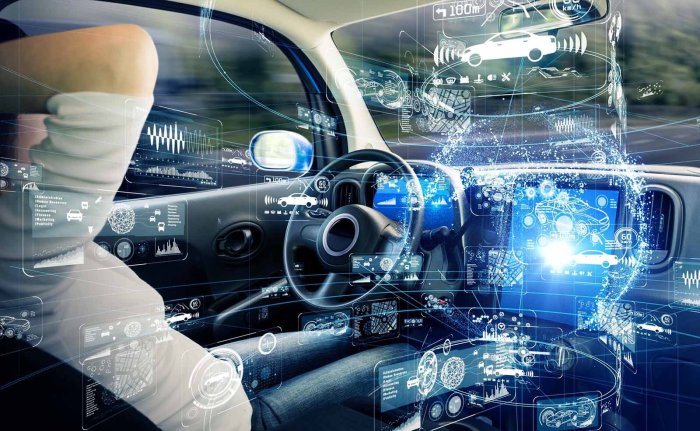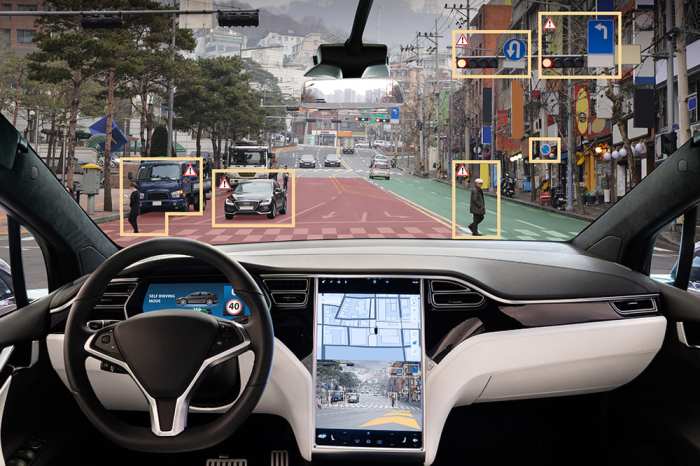Kicking off with Latest technology in autonomous vehicles, this article delves into the most recent advancements in the autonomous vehicle industry. From artificial intelligence to advanced sensors, discover how technology is transforming the way we think about transportation.
Overview of Autonomous Vehicles: Latest Technology In Autonomous Vehicles
Autonomous vehicles, also known as self-driving cars, are vehicles that can operate without human intervention. These vehicles use a combination of sensors, cameras, radars, and artificial intelligence to navigate roads, detect obstacles, and make driving decisions.
Levels of Autonomy
- Level 0: No Automation – The driver is in full control of the vehicle at all times.
- Level 1: Driver Assistance – The vehicle can assist with either steering or acceleration/deceleration, but not both simultaneously.
- Level 2: Partial Automation – The vehicle can control both steering and acceleration/deceleration simultaneously, but the driver must still be ready to take control at any time.
- Level 3: Conditional Automation – The vehicle can manage most driving tasks, but the driver must be prepared to intervene when necessary.
- Level 4: High Automation – The vehicle can perform all driving tasks under specific conditions and may not require human intervention.
- Level 5: Full Automation – The vehicle is fully autonomous and can operate in all conditions without human intervention.
Benefits and Challenges
- Benefits:
- Improved Road Safety: Autonomous vehicles have the potential to reduce accidents caused by human error.
- Increased Efficiency: Self-driving cars can optimize routes and reduce traffic congestion.
- Enhanced Accessibility: Autonomous vehicles can provide mobility solutions for individuals who are unable to drive.
- Challenges:
- Regulatory Hurdles: Laws and regulations need to adapt to accommodate autonomous vehicles.
- Security Concerns: Cybersecurity threats pose risks to the safety of self-driving cars.
- Ethical Dilemmas: Autonomous vehicles raise questions about decision-making in emergency situations.
Latest Technological Advancements

Autonomous vehicles are at the forefront of cutting-edge technology, with continuous advancements being made to enhance their capabilities. One of the key technologies driving this progress is artificial intelligence (AI), which plays a crucial role in the development of autonomous vehicles.
Artificial Intelligence in Autonomous Vehicles
AI algorithms are used to process vast amounts of data collected by sensors, cameras, Lidar, and other technologies in real-time. This allows the vehicle to interpret its surroundings, make decisions, and navigate safely without human intervention. Machine learning techniques enable autonomous vehicles to learn from experience and improve their performance over time.
Sensors and Cameras
Sensors such as radar, ultrasonic sensors, and LiDAR (Light Detection and Ranging) are essential for detecting obstacles, pedestrians, and other vehicles on the road. Cameras provide visual information that helps the vehicle identify lane markings, traffic signals, and signs. The combination of sensor data and camera images allows autonomous vehicles to create a detailed map of their environment and make informed decisions while driving.
LiDAR Technology
LiDAR technology uses laser pulses to measure distances and create high-resolution 3D maps of the vehicle’s surroundings. This technology is crucial for accurately detecting objects at a distance and navigating complex environments. As LiDAR technology advances, it becomes more affordable and compact, making it increasingly accessible for integration into autonomous vehicles.
Safety Features
Autonomous vehicles are equipped with a variety of safety features that are designed to prioritize the well-being of passengers, pedestrians, and other road users. These vehicles are programmed to constantly monitor their surroundings and make split-second decisions to avoid potential accidents.
Collision Avoidance Systems
- Collision warning systems: These systems use sensors to detect obstacles in the vehicle’s path and alert the driver or take evasive action.
- Automatic emergency braking: This feature can apply the brakes if a collision is imminent, helping to prevent accidents.
- Adaptive cruise control: This system adjusts the vehicle’s speed to maintain a safe following distance from other vehicles.
Emergency Handling
- Safe stop capabilities: Autonomous vehicles are designed to safely pull over and stop in the event of a malfunction or emergency situation.
- Emergency response protocols: These vehicles are programmed to communicate with emergency services and provide crucial information in the event of an accident.
- Redundant systems: Autonomous vehicles often have redundant systems in place to ensure that critical functions can still operate in case of a failure.
Regulations and Ethics

In the realm of autonomous vehicles, regulations and ethics play a crucial role in shaping their development and deployment. Let’s delve into the current landscape of regulations, ethical considerations, and the challenges of integrating autonomous vehicles into existing traffic systems.
Current Regulations
Autonomous vehicles are subject to a variety of regulations set forth by governmental bodies to ensure safety and compliance on the roads. These regulations cover aspects such as testing, licensing, insurance requirements, and liability in the event of accidents involving autonomous vehicles.
- Regulations vary across different regions and countries, with some being more progressive in allowing autonomous vehicles on public roads for testing purposes.
- Regulatory bodies are continuously updating and revising rules to keep pace with advancements in autonomous technology and address emerging safety concerns.
- Challenges exist in establishing uniform regulations that can accommodate the rapidly evolving capabilities of autonomous vehicles while prioritizing public safety.
Ethical Considerations
The development and deployment of autonomous vehicles raise complex ethical dilemmas that require careful consideration.
- Key ethical issues include decision-making algorithms that prioritize the safety of occupants versus other road users, as well as the ethical implications of accidents involving autonomous vehicles.
- Developers and policymakers must grapple with questions of accountability, transparency, and fairness in the design and operation of autonomous systems.
- Ethical frameworks and guidelines are being developed to address these challenges and ensure that autonomous vehicles operate in a manner that aligns with societal values and norms.
Integration Challenges, Latest technology in autonomous vehicles
Introducing autonomous vehicles into existing traffic systems poses a unique set of challenges that must be overcome for successful integration.
- Issues such as communication between autonomous and traditional vehicles, infrastructure readiness, and public acceptance are critical factors in the seamless integration of autonomous technology.
- Coordinating the transition to autonomous vehicles requires collaboration between stakeholders, including government agencies, manufacturers, and the public to address concerns and ensure a smooth adoption process.
- Educating drivers, pedestrians, and other road users about the capabilities and limitations of autonomous vehicles is essential to fostering trust and acceptance of this transformative technology.
End of Discussion
In conclusion, the rapid developments in autonomous vehicle technology are revolutionizing the future of transportation, promising safer and more efficient journeys for all. Stay tuned for more exciting innovations in this ever-evolving field.
When it comes to annual travel insurance for frequent travelers, it is important to find a policy that suits your needs and provides adequate coverage throughout the year. You can find more information and tips on choosing the right insurance plan here.
For those looking to buy travel insurance online, there are several factors to consider to ensure you get the best coverage at the right price. Check out our guide with useful tips for purchasing travel insurance online here.